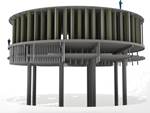RPS Composites Alabama Inc. (Mobile, Ala.) manufactures fiber-reinforced plastic components for two increasingly adopted types of wet scrubbers. Each uses a different method of exposing flue gas to the SO2-reactive water/limestone mixture that cleans up power-plant emissions.
The first is a product of Advatech LLC (Franklin, Tenn.), a joint venture between URS (San Francisco, Calif.) and Mitsubishi Heavy Industries (MHI) America (New York City, N.Y.). The company’s proprietary Double Contact Flow Scrubber (DCFS) technology is a “shower”-type wet scrubber process featuring a very tall absorption tower (e.g., 10 stories) where a limestone slurry is sprayed upward into incoming flue gas and contacts it twice: once as it is sprayed up and again as it falls back down. MHI claims this process has a desulfurization efficiency of more than 98 percent. Advatech scrubbers typically use a concrete building with fiber-reinforced plastic (FRP) internal structures, including support beams, pipes, agitators and mist eliminators — large FRP pipes with arms that spay limestone slurry solution.
In contrast to the Advatech method is the Chiyoda, a “bath” or submergent-type of wet scrubber developed by Chiyoda Corp. (Yokohama, Japan). This system ducts flue gas into its large cylindrical FRP scrubber, where it flows down through approximately 4,600 polyvinyl chloride (PVC) sparger pipes, each 6 to 7 inches (150 mm to 180 mm) in diameter, into the limestone reaction bath of the patented Jet Bubbling Reactor (JBR). The SO2 in the gas reacts with the limestone reagent in the continuously agitated bath and, as the gas bubbles back up, the scrubbing of SO2 is completed before the gas is ducted up through 20-ft/6m high FRP riser pipes ranging in diameter from 26 to 42 inches (0.66m to 1.07m).
From the risers the gas is collected and released through an exit duct as scrubbed emissions. There also is a single gas riser design, which uses one large riser with a diameter of roughly 68 ft/20.7m. This design was developed by Bob Brady of Southern Power Co. (Atlanta, Ga.), an Ershigs founder and a composites pioneer in power-industry applications.
Reportedly, Chiyoda scrubbers are gaining acceptance due to the guaranteed levels of SO2 removal, ranging from 95 to 98 percent. They also require very minimal adjustment to effectively track with variations in power-plant loads, a feature valued by plant operators. Chiyoda scrubbers not only use FRP internals, including an upper and lower deck to support the risers, spargers, agitators and mist eliminators, but they also feature FRP exterior housings, such as the 120-ft/37m-diameter Chiyoda scrubber at Southern Power Co.’s Plant Crist Station in Pensacola, Fla. These housings are reportedly among the largest field-wound composite structures ever fabricated. The JBR tank and flue gas inlet duct also are typically FRP. The latter eliminates the historical need for a flue gas prescrubber to remove chlorides, which otherwise would attack steel alloys. This alone is a distinct cost and time advantage of using composites.
Related Content
-
Materials & Processes: Fabrication methods
There are numerous methods for fabricating composite components. Selection of a method for a particular part, therefore, will depend on the materials, the part design and end-use or application. Here's a guide to selection.
-
CirculinQ: Glass fiber, recycled plastic turn paving into climate solutions
Durable, modular paving system from recycled composite filters, collects, infiltrates stormwater to reduce flooding and recharge local aquifers.
-
Refurbishing bridges at half the time, cost versus replacement
Instead of demolishing and rebuilding bridges, SUREbridge doubles the strength and durability of existing structures with an FRP deck for a smart, sustainable solution.














.jpg;maxWidth=300;quality=90)

